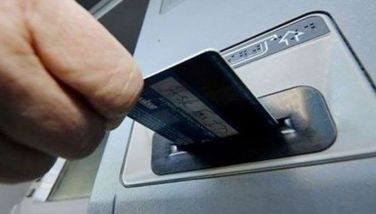Peso unstoppable, now at 40.56
The peso was unstoppable yesterday as it tested the 40.50 to a dollar level on the back of steady inflows from overseas Filipinos and fund managers looking for bargain issues at the stock market.
At yesterday’s trading, the peso gained another 19 centavos to settle at 40.560 to $1 as the dollar continues to weaken and foreign funds found their way into the market amid easing pessimism.
The local currency opened strong at 40.70 at yesterday’s trade, hitting an intra-day low of 40.765 to the dollar before going up to as high as 40.55 and finally closing at 40.56 against the greenback.
The peso was
Trading remained brisk at the Philippine dealing system with over $872 million worth of currency changing hands during the session.
The peso’s steady appreciation stemmed from strong inflows both from overseas workers and portfolio investments as long-term investors went bargain-hunting at the stock market.
Traders said the market was still looking at a strong peso with the widening expectation of ultimately breaching the P40:$1 level sooner than later as risk-aversion appeared to have dissipated.
Traders said the market was also expecting another cut in US interest rates which would release even more liquidity into the system and they said more of these funds would go to emerging markets.
Central bank government Amando M. Tetangco Jr. said foreign funds would continue to flow into the country even if investors were averse to risks in the emerging market.
“Our fundamentals will carry us over this risk-aversion,” Tetangco said. “When funds are looking for profit, they become more discerning and they will differentiate between markets.”
Because of these inflows, supported by robust remittances from overseas Filipinos, Tetangco said the BSP expected the peso to remain firm throughout the year.
Powered by the steady inflow of foreign exchange from remittances and investments, the peso is expected to pick up even more strength in 2008 and hit levels above P40 to the US dollar._As monetary officials began to sound off the alarm that the strong peso was beginning to have adverse effects, economists said the scenario was not likely to change next year and could result in an even stronger peso._JP Morgan economist Sin Beng Ong earlier said the peso could potentially go below P40 to the $1 in 2008 as a result of the resilient and sustained strength of the country’s large current account surplus._According to Ong, foreign exchange inflows would come largely from portfolio investments and remittances from overseas Filipinos in 2008 despite the expected slowdown in the US economy._The strength of the peso, however, was beginning to be a thorn in the side for economic planners and monetary officials who have been reluctant to say that the appreciation of the currency was potentially damaging._Despite the costs of the strong peso, however, monetary officials said this strength was the country’s shield against skyrocketing oil prices that would have even worse impact on domestic prices.
But preliminary studies by the BSP indicated that the economy was beginning to show early symptoms of the so-called Dutch Disease which could result in the sharp contraction of the economy if not addressed properly._The so-called Dutch Disease broadly refers to the harmful effects of large inflows of foreign currency, beginning with loss of competitiveness that could ultimately trigger a decline in the manufacturing sector._According to the BSP it was looking at whether the same phenomenon was beginning to show as a result of strong forex inflows from investments and remittances but she said the first analysis showed no sign of the disease._The BSP said its recent runs indicated a real appreciation of the peso against a basket of currencies that include the country’s main competitors in the world export market.
- Latest
- Trending


























